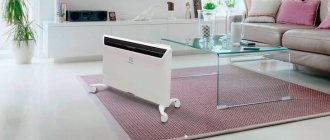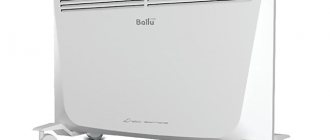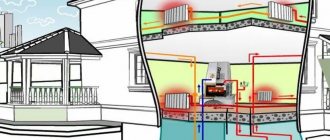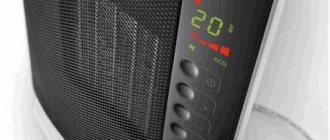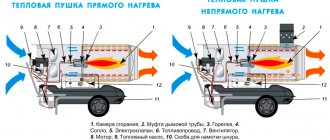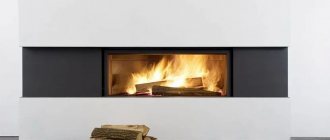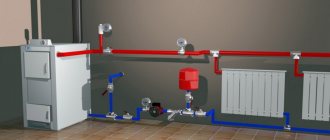An electric convector, like a life preserver, helps cope with low temperatures in our homes during the off-season. The management company has strict regulations for supplying heat to apartment buildings, but the weather has its own, uncoordinated schedule. Solving the problem of discomfort today is not difficult; you just need to go to the nearest store and buy a heater.
Let us make a reservation that the review will not contain an economic comparison of the option of completely replacing the traditional heating system of a house with heating the home using an electric convector. We consider polemics on this issue to be completely inappropriate. Today we are trying to figure out how profitable it is to buy an electric convector, solely in terms of its operation as an additional source of thermal radiation in our apartments.
What is a convector?
The market offers a variety of types, where it is quite easy to get confused. Oil radiator, electric convector, infrared emitters, your head is spinning from the range and price offers. We will devote our review to the electric convector. The principle of operation of the convector is based on the physical properties of heat transfer from the coolant, in our case from the heating element to the heated room using internal energy, which is transmitted by jets and flows, that is, by convection.
In simple words, a heating element is built into the convector, which makes the air around it hot. The heated air begins to move upward, making room for cold air flows. This “cycle” is called natural convection. We hope we have answered the question of what a convector is. A picture will help you understand this simple process more clearly:
Operating principle of an electric convector
As we can see, the electric convector has a simple principle of operation. By the way, since air movement occurs due to convection, the device does not require additional equipment with a fan, thus the electric convector earns a plus in its piggy bank. Of course, this is not the only advantage that forces us to choose an electric heating convector to ensure a comfortable climate in our apartment, but first things first.
Oil radiators
The operating principle of oil heaters is similar to water heaters. The difference is in the use of mineral oils rather than water as a coolant.
A heating element is installed inside, heating the oil, which transfers heat to the air masses around. As a rule, it is not used as the main heating device. The heater can be installed anywhere - in the recreation area, against the walls, under the table.
Advantages:
- fast heating of a large area;
- silent operation;
- presence of a built-in thermostat;
- possibility of movement;
- no installation required.
Oil radiator
Flaws:
- strong heating of the case;
- constant monitoring of the operation of the device;
- high price.
Convector heating pros and cons
One of the main questions of interest to our readers remains the aspect of the feasibility of the purchase. Why a convector, and not an oil radiator, for example? What power characteristics should an electric convector have? How to choose the best one among the incredible assortment?
From a certain point of view, any equipment must contain pros and cons; an electric convector is no exception. We will start by listing the positive qualities, especially since they many times exceed the disadvantages of an electric convector.
1. We consider the main advantage to be a technological breakthrough that allows us to design an electric convector with an efficiency of 95%. Agree, paying for electricity and getting zilch as a result would be an unaffordable luxury. A modern convector converts electrical energy into heat with maximum efficiency.
2. The low price for an average 1000 W electric convector is a strong argument in favor of the purchase.
3. Quiet operation. An electric convector does not require a fan or any other mechanically moving structural elements. Silent operation is periodically interrupted by a barely audible click of the temperature sensor, which contributes to more economical operation of the device.
4. Lack of installation and maintenance work. An electric convector is considered a household appliance, connects to a 220-volt network and does not require permits from government organizations. The small mass of the convector is an additional plus when it comes to relocating the device in a heated room
5. Built-in automation helps maintain the required temperature in the heated room. Remote temperature sensors, made like sockets with a thermostat, additionally provide temperature control.
6. The heating element of an electric convector reaches the set temperature in a couple of minutes, starting to heat the room immediately after switching on. The element temperature, as a rule, does not exceed 60 °C, preventing heating elements from “drying” the air and “burning” oxygen. The absolute humidity of the air in the room does not change. As the temperature rises, only the relative humidity decreases slightly.
7. Low heating temperature of facing surfaces provides a safe environment for people and animals. In addition, you don’t have to worry about fire safety.
8. The service life of convectors declared by a number of manufacturers exceeds 20 years.
Electric heating convector probably has one drawback
So you bought a convector and made sure that your wiring can withstand the additional load. The device, connected to the network, instantly begins to heat the room. As they say, there would be no price for an electric convector if not for one BUT. The only negative, as you might have guessed, is the high cost of electricity consumed. But firstly, as we noted at the beginning of the review, the convector heats our apartment only during the off-season, and not throughout the winter.
Secondly, you need to choose electric heating convectors with a thermostat, then the built-in thermostat will not allow the device to “wind the meter” around the clock. Thirdly, care should be taken to preserve heat and, if possible, reduce heat loss; it is necessary to install double-glazed windows and take care of other insulation elements.
Another disadvantage is the smell of combustion; in fact, it is not oxygen that “burns”, but the dust that has settled on the electric heating element. To remove this drawback is as easy as shelling pears, either vacuum the convector, or simply wait until the dust completely burns out.
Editor's Choice
Convector Electrolux ECH/AG2−2500 T with control unit TUI3 (average price 9,880 rubles)
Convector Electrolux ECH/AG2−2500 T with control unit TUI3.
Photo: yandex.market.ru Our rating opens with the Electrolux ECH/AG2-2500 T . It is equipped with a TUI3 control unit. This model is suitable for heating any type of premises (small office, room in a country house, etc.). The convector can be used as the main or additional heat source. Innovative technology Transformer System Air Gate 2 allows the consumer to freely control the equipment of the device. The model consists of a heating module (base part) and a removable control unit. It also features a BIO Filter System with four different filters. In particular, antistatic, antiseptic, carbon and catechin.
Characteristics
| Equipment set | Yes |
| Heating element type | monolithic |
| Voltage | 220 V |
| Ventilation without heating | No |
| Inverter power control | There is |
| Control | display, remote control, switch with indicator light |
| Mounting options | wall, floor |
Advantages and disadvantages
Elegant design, waterproof housing, overheat shutdown
High price
show more
Xiaomi Mi Smart Space Heater S KRDNQ03ZM (average price from 6,000 rubles)
Xiaomi Mi Smart Space Heater S KRDNQ03ZM. Photo: yandex.market.ru
Uniform heating of the air without drying out is what distinguishes this heater from its competitors on the market. However, this model has a number of distinctive features. Thus, the convector can be controlled using a special application for smartphones. The model is equipped with a thermostat and temperature controller with indicator lights. In addition, the heater is equipped with two protective mechanisms against overheating and tipping over. Child protection is also provided. These characteristics, combined with a stylish body, make the Xiaomi Mi Smart Space Heater S very attractive to the buyer.
Characteristics
| Heater type | convector |
| Heated room area | 22 m² |
| Heating power | 2200 V |
| Heating element type | spiral |
| Number of operating modes | 1 |
| Additionally | thermostat, timer, temperature control |
| Control | electronic |
| Mounting options | floor |
Advantages and disadvantages
High build quality, control via smartphone
Some users complain about problems with the software
show more
Convector REDMOND RFH-C4519S (average price 7,400 rubles)
Convector REDMOND RFH-C4519S. Photo: yandex.market.ru
REDMOND RFH-C4519S is a stylish and well-built device. The body of the device is made of black plastic. This device comes with a stand. The electric convector stands on it quite steadily. You won't be able to accidentally knock it over. The gadget is controlled by mechanical buttons. It can also be connected to a smartphone. However, at the moment, the application’s capabilities only completely duplicate the functionality of mechanical buttons. There are no additions provided there. The convector is capable of heating a room up to 20 square meters.
Characteristics
| Power adjustment | There is |
| Max. heating power | 2000 W |
| Heating element type | ceramic |
| Maximum heating area | 20 sq.m |
| Voltage | 220/230 V |
| Number of operating modes | 3 |
| Control | electronic, temperature adjustment, delay start, switch with indicator light |
| Timer | There is |
| Bluetooth | There is |
| Mounting options | floor |
Advantages and disadvantages
Overheat protection, attractive appearance, voice control via app
A little noisy, only two power control modes (“standard” and “turbo”)
show more
Electric convector - calculation of kW consumption.
Agree, buying an electric convector is one thing, but how much we will have to pay for the heat received is quite another, that is the question. We emphasize that our calculation of consumption is based on personal operating experience, and not on manufacturers’ formulas. Let us also make it clear that we do not heat the house in the frosty winter, we raise the temperature in the room to a comfortable state. Let's consider an average room of 18 m2. The technical characteristics of any manufacturer for heating a room of such area regulate the purchase of a 1000 W convector.
Let us clarify that to start central heating, municipal authorities are guided by the Decree of the Government of the Russian Federation dated May 6, 2011 N 354, according to which the street temperature must drop below +8 ºС and not rise for 5 days. I think many will agree that usually, in the off-season, it can take a month to achieve this goal, and the temperature outside the window is + 12°C, already reducing the temperature in city apartments to + 16 – 17°C.
Consumption calculation
We plug in the electric convector and set it to a comfortable 22 °C. We will not go into calculations; everything has been tested many times experimentally. With the door closed and the window closed, in full power mode at +17 °C. up to +22 °C. , a 1000 W convector runs for about 25 minutes. You can always double-check this and write your result in the comments.
When the set value is reached, the temperature control system will work and the consumption of electrical energy will stop. As it cools down, noticeably after 20 minutes the temperature sensor is triggered and turns the convector back on. Considering that the next switching on does not require heating from 17 °C, but starts from 20 °C, then the time to reach the value is 22 °C. much less, no more than 10 minutes. Then the on/off cycle is repeated and the average heater operation does not exceed 20 minutes per hour.
Actually, based on the experimentally obtained data, we obtain the consumption of an electric convector. Divide 1000 W by 60 minutes and get 16 W - we determined the electricity consumption of one minute of operation. In our experiment, the convector worked for no more than 20 minutes. Now we multiply 16 W by 20 minutes and get the power that the convector consumed per hour of operation - 330 W. Thus, the convector “eats” 1 kW in three hours. The cost of one kilowatt at the beginning of 2022 is 4 rubles.
Gentlemen, per evening we will need no more than 9 hours of operation of an electric convector - 12 rubles. A month in the off-season will cost about 360 rubles. To be on the safe side, let’s add another 30% to this amount (for those who sit too long in front of the TV). The total cost of operating the convector will be 400 – 500 rubles for normal temperature conditions for a month. Let me ask you a question: is it worth saving this amount, exposing your body and your household to the risk of cooling? Sick leave and a bad mood are much more expensive; drops for a runny nose alone can offset this kind of savings.
Choosing the best electric convector
The principles that will help you choose a convection heater for an apartment, cottage or house remain unchanged. Our goal is to choose, not illusively, the best electric convector, but a reliable device that will provide us with good warmth and take up a lot of space, and even better fit into the interior and become a unique highlight.
Step one
Heating power is the main characteristic of a convector. Traditionally, calculations are based on the conditions that 100 W are required for heating per 1 m2. Are you probably scared by the prospect of spending 1000 watts per hour to heat a 10 m2 room? But we are going to buy an electric convector for additional heating! Therefore, we safely advise you to buy a device with lower performance. For additional heating of 18 m2, 1 kW of power is quite enough, and even then, most likely you will use half the power.
Modern devices are equipped with step-by-step heating control. This way, it will be easier for you to select the required power at home, even if you decide to buy an electric convector with a “reserve”
Step two
Probably the most pleasant in our review, and it is dedicated to design. Of course, there are not many options for creativity, but still. Electric convectors can be found in traditional white colors and other colors, even mirrored options. We also select design solutions according to needs; the standard convector has the same height, around 45 cm, but varies in length depending on the power. In addition, there are interesting offers of flat models and a space-saving plinth convector.
Step three
A really important point is to decide on the thermostat in our device. The manufacturer completes products ranging from inexpensive mechanical sensors to expensive electronic ones. Electronic thermostats are the most accurate. A mechanical thermostat, on the one hand, is cheaper, on the other hand, it has low accuracy and is more susceptible to wear. The electronic device responds to a change of 0.1 degrees, in addition, it has the ability to be programmed.
Here we leave the choice of convector control up to you, since in the future, you can always buy an additional socket with a thermostat and expand the capabilities of your inexpensive device. Let us only add the unconditional fact that an accurate thermostat will contribute to the greatest energy savings.
How to reduce heating costs
We have written more than once that reducing heat losses helps make electric heating cheaper. How to reduce heating costs? Here are the basic steps to help reduce your energy costs:
The main indicators of heat loss in private houses. If you insulate the walls, floor and attic, as well as install good windows and doors, you will save significantly on heating.
- insulation of doors - if your house has uninsulated doors, feel free to throw them in the trash. Spend some money and buy a normal door with good thermal insulation;
- triple glazed windows will help reduce heat loss by about 10% . Heat loss is also reduced by reducing the area of window openings. This isn't always possible, but you can simply brick up a couple of unnecessary windows;
- insulating the attic will provide another 5-10 percent savings;
- creating additional thermal insulation of walls - for example, by covering a house made of a cement block with bricks and mineral wool, you will get significant savings.
Some of these tips are easiest to implement at the stage of building a home - do not create too wide window openings and once again review the number of windows, provide insulation with mineral wool or other thermal insulation, think about insulating the attic, immediately order triple energy-saving double-glazed windows.
